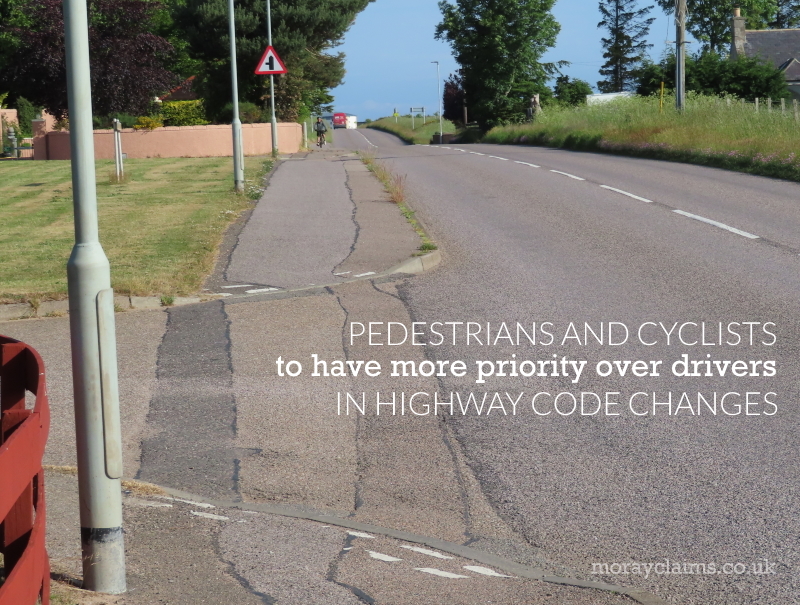
Walking and cycling have become more popular during the pandemic.
So-called “active travel” has benefits for personal health as well as the environment.
Department for Transport figures show that, over the last year, there’s been a 46% increase in the number of miles cycled on British roads. Tellingly, that’s a larger increase than in all of the previous 20 years combined.
To take even one corner of Moray as an example…
While the Lossiemouth – Elgin cycle path beside the A941 has been an active travel benefit for many years, the long-mooted track to connect Lossiemouth to Hopeman has only recently gained significant traction, despite years of campaigning.
Now that the charitable organisation (SCIO) Laich of Moray Active Travel Routes is in existence, and with help from Sustrans, a connection between Lossiemouth and Covesea is coming.
Hopefully, the final link from Covesea to Hopeman – to cover places such as the Green Road, Gordonstoun and Duffus – will not be far behind.
The Westminster Government is keen to build on the public appetite for active travel.
This will include funding for improved infrastructure and also proposed changes to the road traffic laws which regulate interactions between pedestrians, cyclists and vehicles. Changes to the Highway Code could come in before the end of 2021.
The overarching policy behind altering the Highway Code is to improve safety for all road users.
Under the present system, all road users, from, say, car transporter lorry drivers to child pedestrians, are equally responsible for their own safety.
The updated Highway Code will introduce a “hierarchy” of road users.
Under this, for example, drivers are responsible for cyclists’ safety and, in turn, cyclists are responsible for the safety of pedestrians.
The net result is that pedestrians and cyclists will have more priority over drivers.
DfT thinking here – which makes sense to personal injury lawyers – is that road users with the potential to do the greatest harm have the greatest responsibility to reduce the danger they may pose to others.
Whereas at present vehicle drivers only have to give way to pedestrians once they step on to a zebra crossing, the new laws will improve pedestrians’ priority when on pavements – and also when crossing or waiting to cross the road. Motorists and cyclists will also require to give way to pedestrians when turning at junctions if they are crossing, or waiting to cross, the road.
Cyclists will get additional protection via guidance on safe passing distances and speeds.
Around 75% of crashes involving cyclists take place at junctions.
Cycling safety groups have long advocated that cyclists should be given priority when travelling straight ahead at junctions (e.g. across the mouth of a T-junction). It appears this measure will be brought in.
To return to the Lossiemouth to Elgin cycle path as an example, it will be interesting to see how the new road regulations will affect the numerous vehicle-cycle T-junctions.
- RAF Lossiemouth east-side “goods” entrance from B9135.
- RAF Lossiemouth unclassified south-side road past Duffus Castle, connecting to B9135.
- Muirton village (3 junctions with B9135).
- Unclassified road connecting Covesea Road with Lossiemouth Road (A941), north of Elgin.
- Findrassie Housing development entrance(s) (from A941).


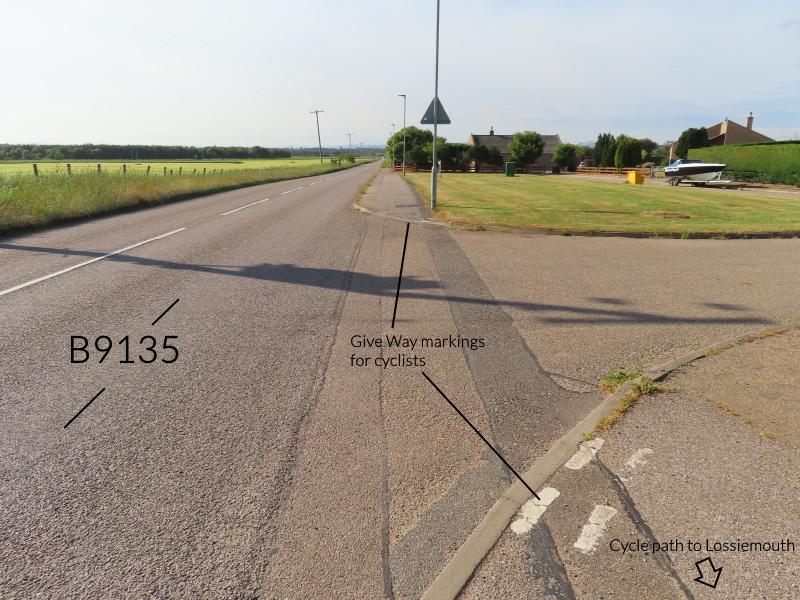
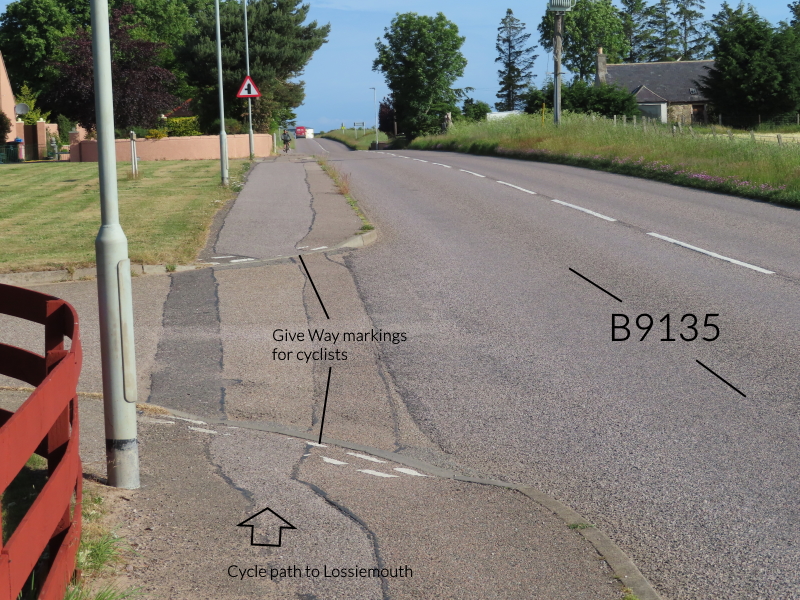
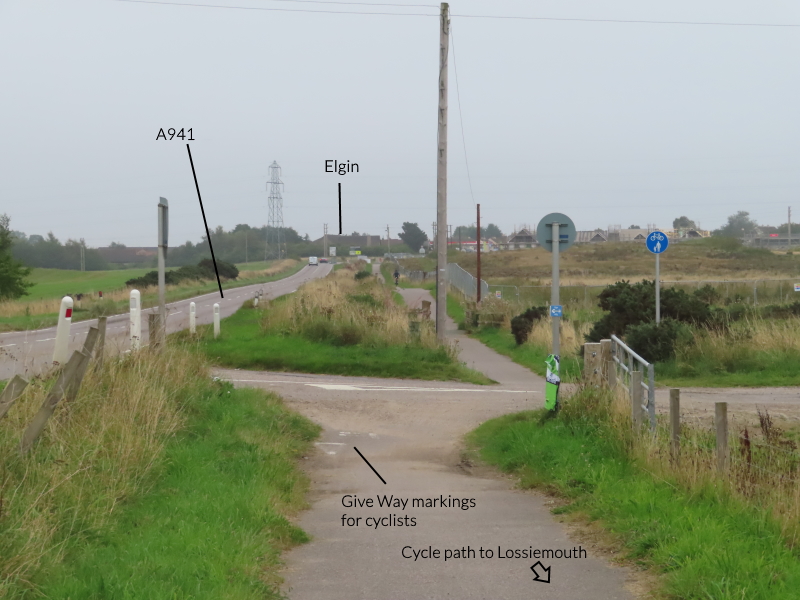
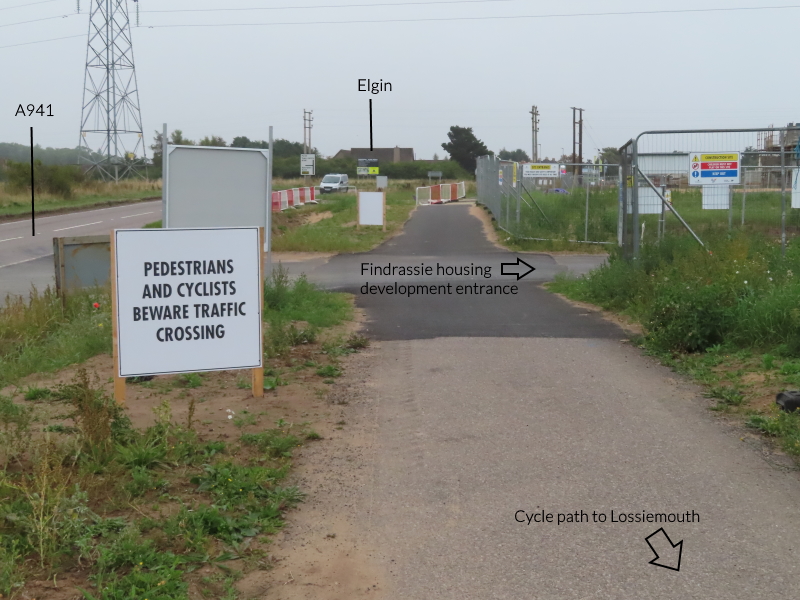
As can be seen from the images above, currently, the requirement for cyclists to give way when on the cycle path (yet going straight on) is often either poorly marked or simply left to the imagination.
Clarity either way would be an improvement. But priority for cyclists will improve general road safety. It will also perhaps encourage more commuters to get on their bikes. More bikes means less vehicles on the road.
The hierarchy of road users is more in tune with principles already applied by the courts in personal injury cases.
“Causative potency” or potential to cause damage can come into play where the blame for a road traffic accident does not just fall on one person.
A common example is where an injured person was travelling as a passenger in a vehicle driven by a person who they knew to be over the drink-drive limit.
When considering legal responsibility for an accident, a Court will consider who is at fault and also whether the injured party’s conduct contributed to the damage occurring – and to what (percentage) extent.
Where a pedestrian or cyclist is deemed to have contributed to their own “downfall”, the Court will probably make a deduction from their award of compensation to take account of their share of the blame.
The level of the deduction for contributory negligence will take into account the concepts of causative potency and moral blameworthiness.
Causative potency looks at things like:
- how big you (or you and your vehicle) are;
- how fast; and
- how heavy.
From that, can you see how a causative potency imbalance arises between vehicles and more vulnerable road users?
Given the potential increased damage a vehicle can cause due to its size, weight and speed, it has higher causative potency than cyclists or pedestrians.
While a pedestrian may be held at fault for crossing the road without checking for oncoming vehicles, all other things being equal, the driver will still likely have to pay more than 50% of the full, assessed compensation if they were at fault in some way.
In a fairly recent case of high authority, having been decided in the Supreme Court (Jackson v Murray – 2015), a 13-year-old girl who had just exited a minibus ran across a rural Aberdeenshire road to get to her home.
She failed to check for oncoming traffic before crossing.
She was struck by a car travelling at 50 mph and suffered serious injury.
You can read in more detail about the case of Jackson -v- Murray in a separate article on this website HERE.
Her award of compensation was reduced by 50% due to her contributory negligence in not keeping a proper lookout.
Just because you are the more vulnerable road user in a collision, it does not prevent you being 100% to blame for the accident and its consequences.
Courts take into account all the facts and circumstances when deciding who is at fault for an accident.
In the 2021 case of Wallace -v-Roache the Sheriff Appeal Court found entirely in favour of driver who had been in collision with a cyclist.
The accident happened in St Andrews. The cyclist crashed into a vehicle which had pulled out in front of him when exiting a car park through a gate. There was a sign indicating that cyclists should give way to vehicles on the access road.
Approaching the junction at about 20mph, the cyclist had ignored the “give way” sign. The court said the cyclist’s claim demanded a “counsel of perfection” on the part of the car driver, where the law required only reasonable care to be taken.
It’s probably stating the obvious to say that a cyclist is going to have to take care for other road users when using a path which crosses a road. On the face of it, this cyclist had taken no care for their personal safety or for the rules of the road, so failing to prove liability on the part of the car driver should come as no surprise.
The case shows that the legal duty on a cyclist to take reasonable care and to comply with road signs is no less when cycling on a cycle path than on a road.
Where you travel a particular route regularly – especially as a commute – it’s easy to become dulled to the rules and risks which apply.
While the proposed Highway Code changes could possibly have brought an entirely different (successful) result for the injured cyclist in Wallace (who was “going straight on at a junction”), in the meantime, cyclists and pedestrians in similar circumstances – such as on the Elgin to Lossiemouth cycle path – should assume they need to give way at all junctions with other roads.
How we can help
The likely changes to the Highway Code in 2021 will improve legal protections for vulnerable road users and should contribute to improved road safety. We’re hoping they will reduce accident numbers.
Should a personal injury accident nevertheless occur, the new rules will give the vulnerable road user a better chance of making a successful (and less contributorily negligent) compensation claim
Should you have any questions arising from this article or about any aspect of our personal injury claims services generally, please get in touch by phone or Free Online Enquiry. All initial enquiries are free of charge and without obligation. You can contact Peter or Marie in our Elgin office on 01343 544077. Or you can send us a Free Online Enquiry.
We strongly advise any pedestrian or cyclist injured in an accident to get local, specialist legal advice as soon as possible.